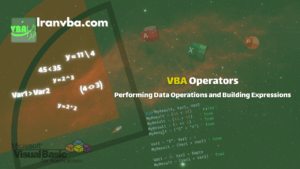In the previous tutorial, we learnt how to declare variables. In this part of the free VBA training series, we’ll explore the concept of Variable Scope and how it defines access to variables across different parts of a project.
In large VBA projects, understanding variable scope is crucial. If a developer doesn’t know where a variable is valid, data may be unintentionally modified or reused in other areas of the program. Therefore, understanding scope is one of the foundations of writing clean and error-free VBA code.
Types of Variable Scope in VBA
The scope of a variable determines in which parts of the VBA project it can be accessed. Generally, there are three main levels of scope in VBA:
| Variable Type | Declared In | Accessible Within | Value Retained |
|---|---|---|---|
| Local (Dim) | Inside a procedure | Only that procedure | Until the procedure ends |
| Local (Static) | Inside a procedure | Only that procedure | As long as VBA is running |
| Module-level (Private/Dim) | At the top of a module | All procedures within that module | As long as VBA is running |
| Public | At the top of a standard module | All modules in the project | As long as VBA is running |
1. Procedure Scope (Local)
A local variable is accessible only within the procedure where it is declared. These variables are usually declared using the Dim or Static statement.
Declaring a Local Variable with Dim
When a variable is declared with Dim inside a procedure, it remains in memory only until the procedure finishes execution. Once the procedure ends, the variable’s value is lost and will be reinitialised in the next run.
Sub Example1()
Dim X As Integer
X = 100
End Sub
Sub Example2()
Dim X As String
X = "Yes"
End SubIn the example above, two variables with the same name but different data types are declared. Each one exists only within its own procedure and does not interfere with the other.
Declaring a Local Variable with Static
Local variables declared with the Static keyword retain their values between multiple executions of the same procedure, as long as VBA is running.
- If a runtime error occurs and isn’t handled, the value will reset.
- Stopping or closing VBA will also clear the value.
- Editing the module causes a reset as well.
Sub RunningTotal()
Static Accumulate As Integer
num = 2
Accumulate = Accumulate + num
MsgBox "The running total is " & Accumulate
End SubOn the first run, Accumulate will be set to 2, and in subsequent runs, the new value will be added to the previous total.
2. Module Scope
If a variable is declared at the top of a module, outside any procedure, it becomes available to all procedures within that same module. Such variables can be declared using either Dim or Private.
Dim A As Integer
Dim B As Integer
Sub Example1()
A = 100
B = A + 1
End Sub
Sub Example2()
MsgBox A
MsgBox B
End SubIn the example above, the variables A and B are accessible by both procedures within the same module.
3. Public Scope
Public variables have the widest level of access. They are available throughout all modules of a project. These variables must be declared in a standard module using the Public keyword.
' module1
Public SalesPrice As Integer
Public UnitsSold As Integer
Public CostPerUnit As Integer
' module2
Sub CDSales()
SalesPrice = 12
UnitsSold = 1000
CostPerUnit = 5
MsgBox "Gross Profit: £" & (SalesPrice * UnitsSold - (UnitsSold * CostPerUnit))
End SubIn this example, the public variables declared in module1 are accessible in module2 without the need to redeclare them.

🟩 Quick Summary
- Dim (Local): Valid only within the same procedure.
- Static: Retains value between multiple runs.
- Private: Accessible throughout the same module.
- Public: Accessible from any module in the project.
Understanding these levels helps you write more structured and reliable VBA code.
Frequently Asked Questions about Variable Scope in VBA
What does “variable scope” mean in VBA?
Variable scope in VBA defines which parts of your code can access a variable. In other words, it specifies where a variable is valid and how long its value is retained.
What is the difference between Dim and Static variables?
Both are local variables, but a Dim variable loses its value when the procedure ends, while a Static variable retains its value even after the procedure finishes and will continue from that value the next time it runs.
When should I use Public and when should I use Private variables?
Use Public when the variable needs to be accessed across multiple modules. Use Private when it’s only needed within a single module to prevent naming conflicts and unintended changes.
Can Public variables be used in forms and classes?
Yes, but only if they’re declared in a standard module. Public variables inside a form or class are accessible only through that object instance.
Why do developers use Option Explicit?
The Option Explicit statement forces VBA to check that all variables are properly declared using Dim, Static, Private, or Public. It helps prevent runtime errors caused by mistyped variable names.
Reference
Scope of variables in Visual Basic for Applications (Microsoft)
Read More
VBA Procedures | Definition, Types & Usage in Visual Basic
Constants in VBA | Types, Scope, and How to Use Them Effectively
VBA Modules | Types of Modules and the Difference Between a Module and a Class
Operator Precedence in VBA | Order of Arithmetic and Logical Operations with Examples
VBA Operators | Performing Data Operations and Building Expressions


